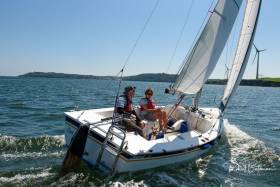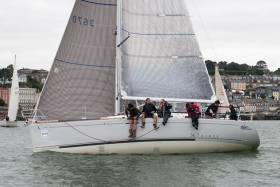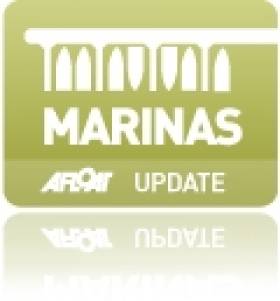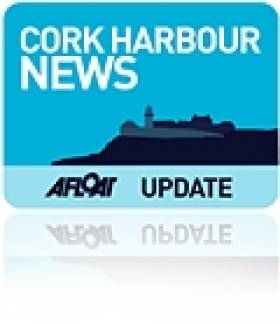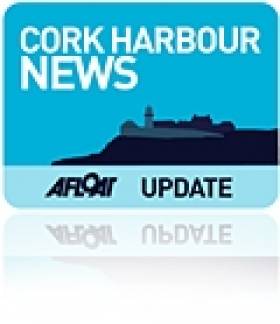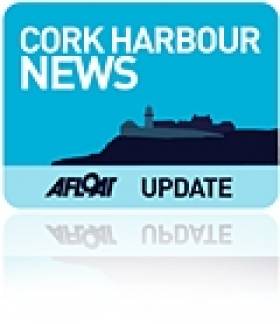Displaying items by tag: Cove
Summer Sails in Cork Harbour for Combined MBSC Cruiser Race
Summertime and the living is easy in Cork Harbour. Despite the postponement of Sunday's Cove at Home Regatta due to the lack of access to landing pontoon at The Quays in Cobh, a combined fleet of nine sailing cruisers coming from RCYC and Cobh (Cove sailing Club and Great Island Sailing Club) and Monkstown Bay Sailing Club for a league race on Saturday as part of 'MBSC at Home' under Race Officer Tom MacSweeney, writes Bob Bateman.
In a lovely summer's afternoon for sailing, the cruiser fleet mixed with an assortment of dinghies.
Cruiser sailors included Ria Lyden sailing an X332, Sean Hanley in a Hunter. Ian Scandrett was sailing the Sigma 38 (with George Radley on board). Eddie English's Holy Grounder and a Hawk 20 also took part.
Photo gallery below

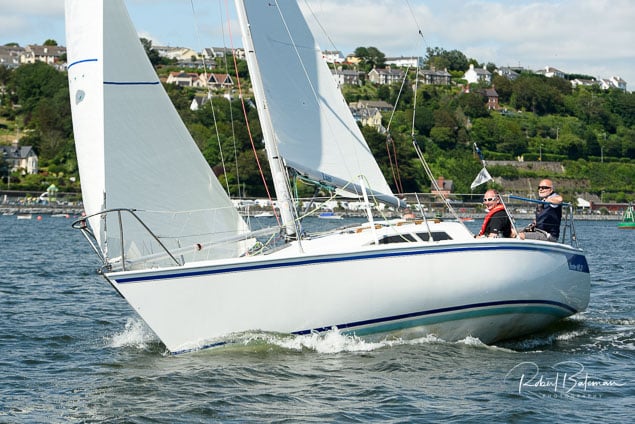
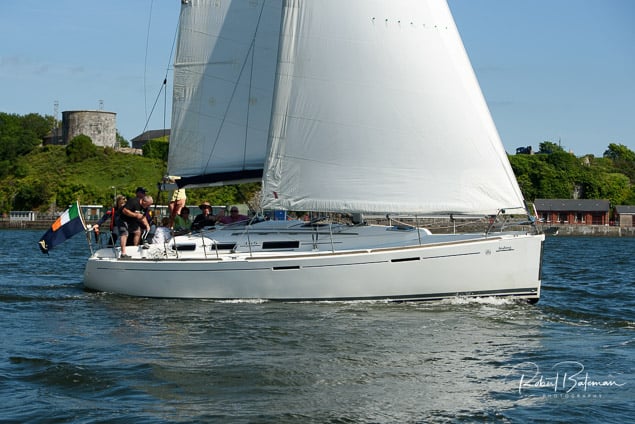
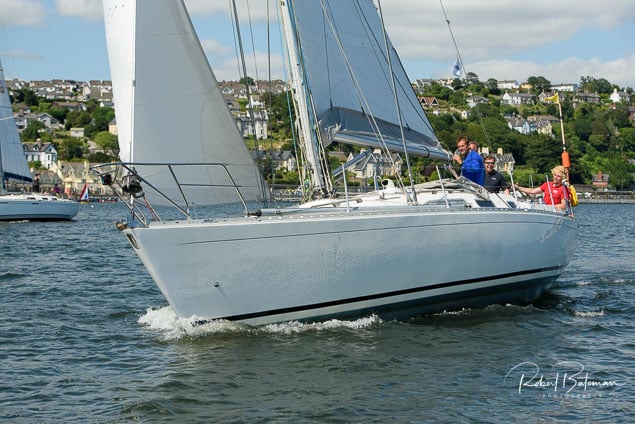
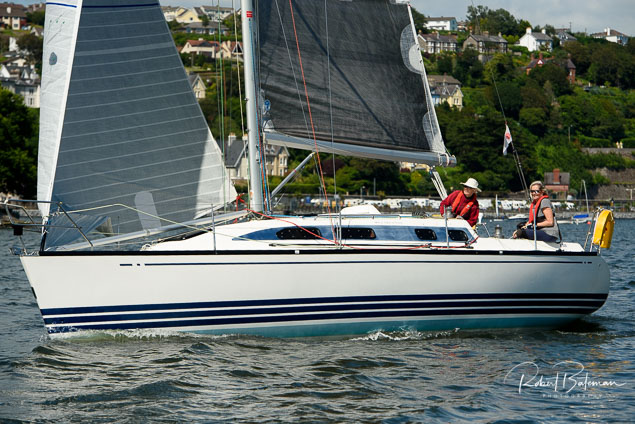
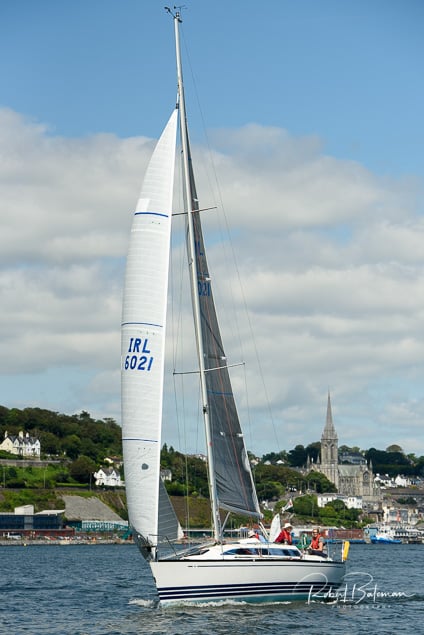
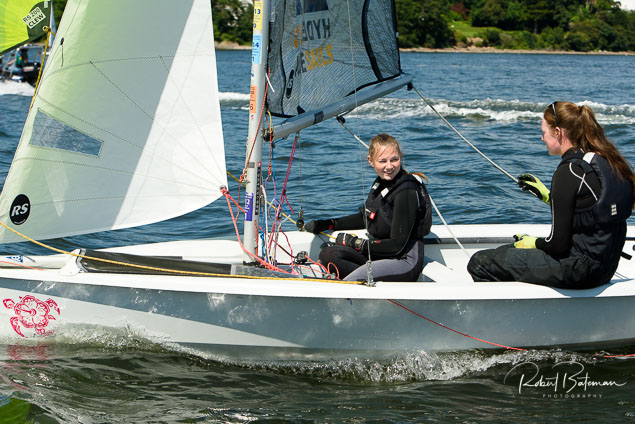


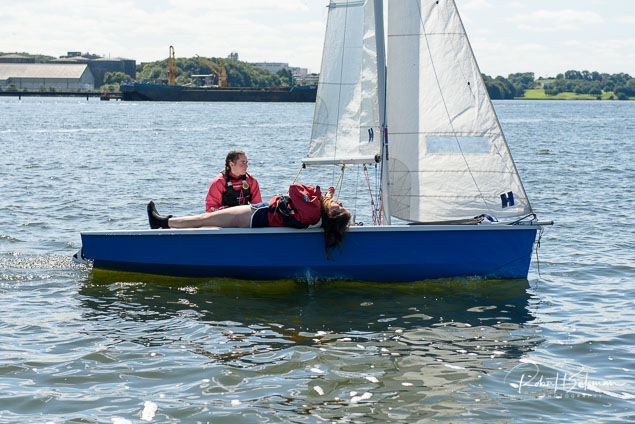

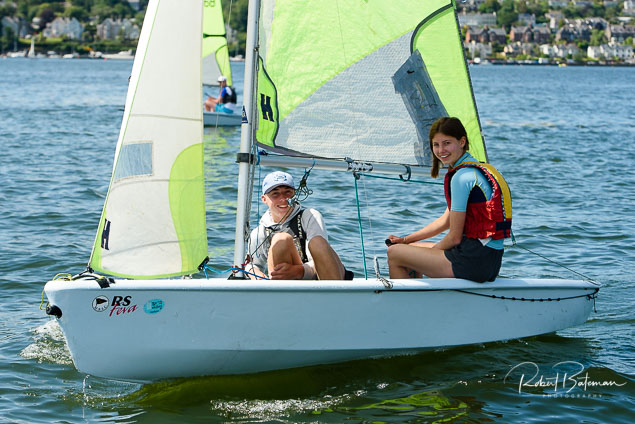

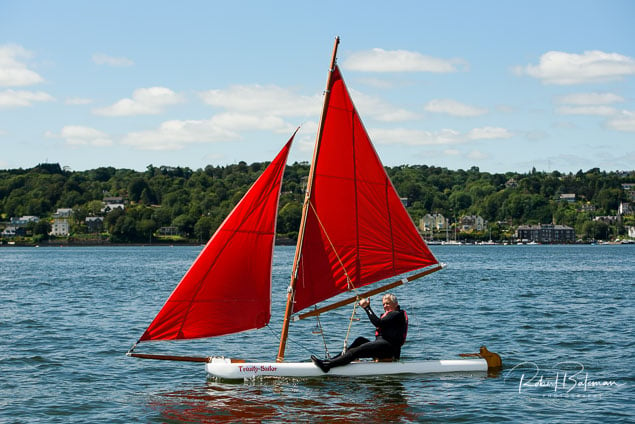
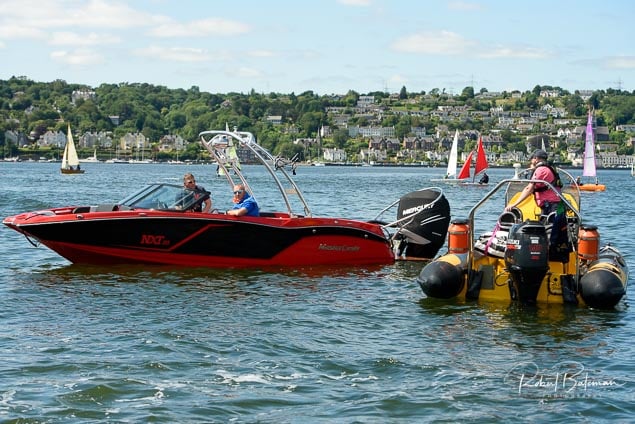
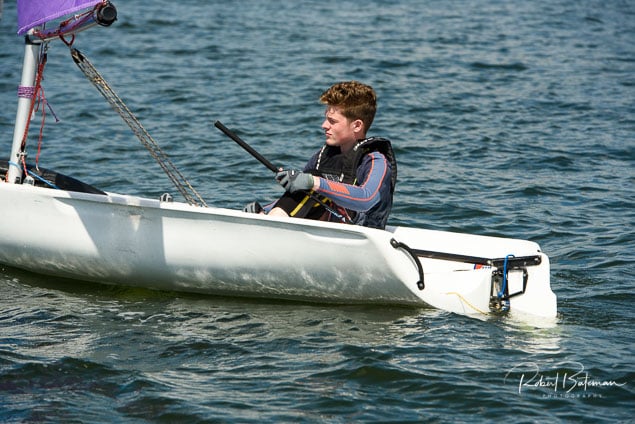
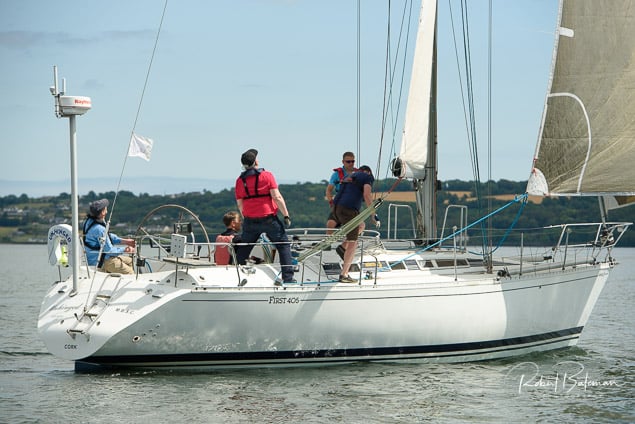
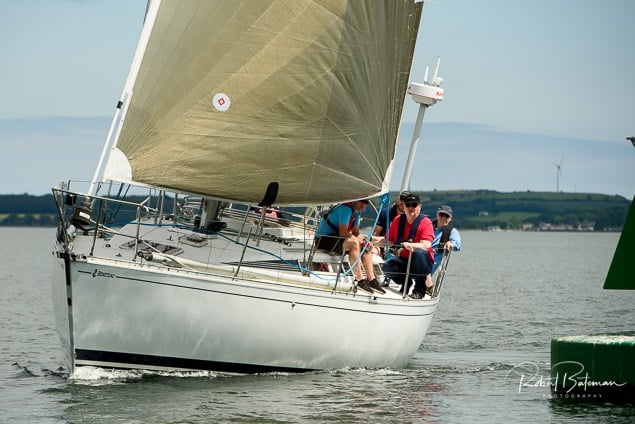
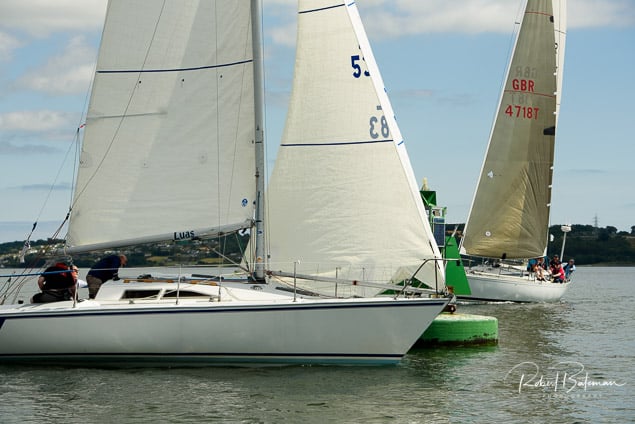
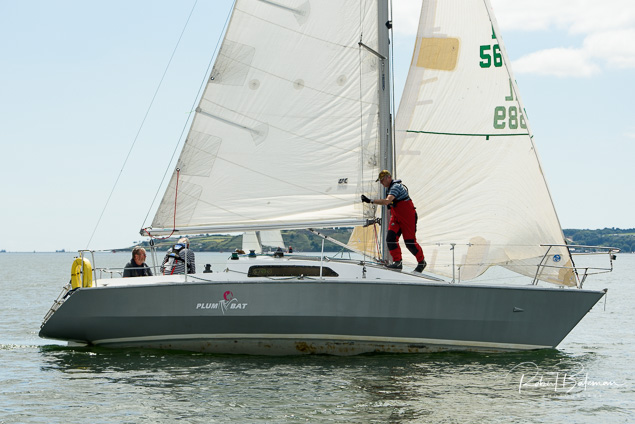
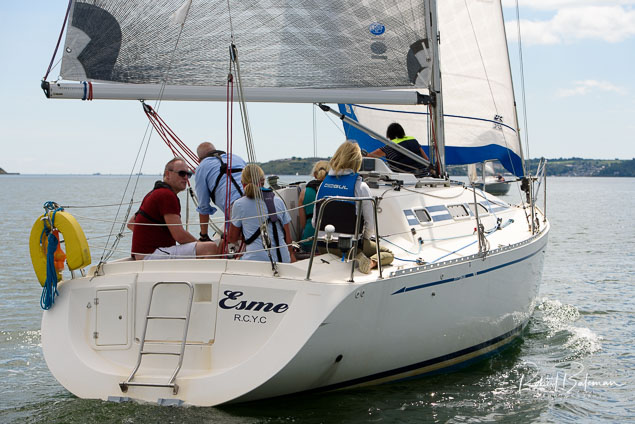
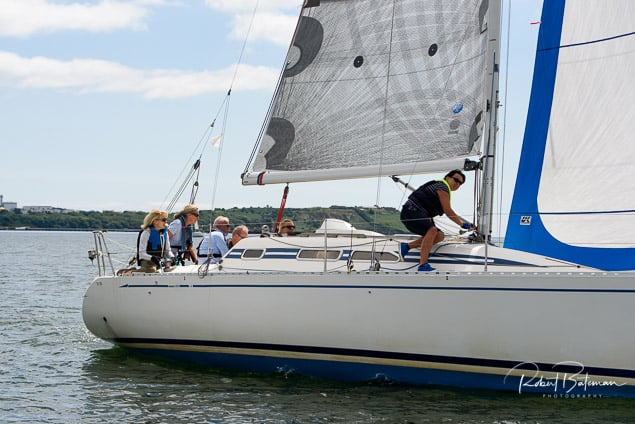





Cork Harbour Cove to Blackrock Race (PHOTO GALLERY HERE)
Cove Sailing Club's own Beneteau First 36.7 Altair was the class one winner of yesterday's annual Cobh to Blackrock race writes Bob Bateman. The Cork Harbour fixture that was postponed due to bad weather a fortnight week ago set sail in light westerly winds yesterday with a good turnout of all sorts of cruisers and dinghies that included some local Rankin dinghy entries.
The course was upriver from the start line at Cobh to the finish line at Blackrock Castle.
Cove Sailing Club Commodore Aidan Mc Aleavey, with support from the Naval Squadron's Soubrette from Haulbowline acting as comittee boat, sent the fleet off with a flooding tide and a beat up to Whitepoint then a reach onwards to Marino Point.
The dinghy fleet started first then the white sail division followed by traditional craft with racing classes 1,2,3 last to start.
Second in class one was Ria Lyden's X332 Ellida with Paul Tingle's X34 Alpaca from Royal Cork third.
George Radley's Half tonner Cortegada was the class two winner. The race is part of CSC September League. Full results are here
Cove Sailing Club Marina at Whitepoint To Open in Cork Harbour in 2015
#corkharbour – Cove Sailing Club will finally have a home in Cork Harbour and Cobh town will get a marina, according to Commodore of Cove Sailing Club Adrian Tyler on Friday.
The new Cork Harbour marina facility adds another important link in the necklace of up to 60 marinas around the Irish coastline.
Tyler made the announcement following a meeting of Cove Sailing Club members it was unanimously passed to go ahead with a 74 berth marina at Whitepoint, Cobh.
The new facility will be built in two phases. The first phase is for thirty berths and this is expected to be operational by early in 2015.
Rear Commodore Derry Allister said that the works will begin immediately. The funding for this 'community marina' is made up of SECAD funding of €125,000 a grant from Cork County Council of €200,000 and club members have sponsored the remaining €300,000 for the project.
President of Cobh & Harbour Chamber Brian Curtis said this marina was a welcome boost to tourism in Cobh this news on the back of Cobh retaining its silver medal position in the tidy towns competition ends a great week for Cobh and gives all the community a boost for next year's tourist season.
Brian Curtis stated that the marina will allow more tourists to visit Cobh and they will at last have a marina to tie their boats up. Without the assistance of our four newly elected councillors working together at Cork County hall with the marina committee this great news would not be possible today.
The marina group also acknowledged the assistance of Mr Louis Duffy of Cork county council in guiding them through the storms of financing the marina.
CSC will be holding a meeting for potential berth holders shortly.
In Cowes, on the south coast of England, IRL1392 Illes Pitiuses (Jason and Dominic Losty) from Cobh are leading the all amateur or Corinthian division trophy after day one of the 2014 Coutts Quarter Ton Cup having won the first race. Onboard is Cork Harbour Olympic Star keelboat sailor Mark Mansfield as tactician.
Yesterday's marks the start of a second week of successful racing for the Cove SC crew who finished 16th overall in last Saturday's massive 1,600–boat Round the Island Race.
Ireland previously won the Corinthian Quarter Ton Cup in 2012 with the George Kenefick skippered Tiger, another Fauroux design like Illes Pitiuses.
Illes Pitiuses leads the pack by single point margin from Pierre Paris's Pinguin Playboy (1986 Castro) with Phil Cook's Purple Haze, the beautiful varnished 1976 version of the Thomas designed Bolero which won the inaugural revival Quarter Ton Cup in 2005, in third. Illes Pitiuses got their day off to a great start by winning race one overall and went on to also claim fourth overall in race three, added to their seventeenth in race two they now lie seventh overall as well as leading the Corinthians.
Warm sunshine, sea breezes and a great fleet of Quarter Tonners are ingredients guaranteed to produce an outstanding day on the water and the opening day of the Cup certainly lived up to everyone's expectations.
Initially the race committee, headed by Race Officer Rob Lamb, was forced to postpone while the sea breeze established itself, but once it arrived three great races were laid on for the 33-strong fleet. As always with the Quarter Tonners it was nip and tuck at every mark and the place changing was constant.
The quality of racing in the Coutts Quarter Ton fleet is always outstanding and for this tenth anniversary edition it seems that the teams have pulled out all the stops. As well as performing beautifully the boats and crews are also looking quite wonderful this year. The oldest boat in the fleet is Tony Hayward's Blackfun, a 1977 Davidson design, whilst the youngest is Richard Fleck's Per Elisa, which was designed by Ceccarelli and won the Quarter Ton Cups of 1995 (Gdynia) and 1996 (Travemunde).
With three races in the bag and a 2, 2, 3 scoreline Rickard Melander's Alice II, a 1990 Phil Morrison design, leads the fleet by a 4.5 point margin. Alice II has regularly featured on the Coutts Quarter Ton Cup podium since her first appearance in 2010 and must surely hope that this year they will finally be the bride and not a bridesmaid.
Lying in second overall is Peter Morton's Bullit, a 1979 Fauroux that won the Quarter Ton Cup in San Remo the year she was launched. Under Peter's ownership she also won the 2012 Coutts Quarter Ton Cup in Cowes and the team clearly have their eye on adding their name to the trophy for a third time. Their performance improved as the day wore on, starting with a seventh in race one, followed by a dead heat for third with Tony Haywood's Blackfun (a 1977 Davidson design) in race two, and finally a win in race three.
Tonight's overall top three is rounded out by Willie McNeill's Illegal Immigrant, a 1991 Ceccarelli design which acquired her name when customs officers found an illegal immigrant in the boat when she arrived at the UK border after Willie purchased her from Greece. After a slightly wobbly start with an eleventh in race one Illegal Immigrant went on to add a second and a win to her score line putting her 2.5 points behind Bullit.
The racing is so close that dead heats on corrected time are common. In addition to the tie between Bullit and Blackfun noted above there were three further dead heats today: In race two Enigma, the 1977 Dubois design now owned by the Stewart/Young/Smith partnership, and Graham Hetherington's Great Bear IV (1986 Joubert Nivelt) tied for thirteenth, and in race three Eric Reynolds' Magnum Evolution (1976 Everitt) and Phil Cook's Purple Haze (1976 Thomas) tied for twelfth and Rob Gray's Cote (1990 Gonzalez) and Cartoon tied for fourteenth.
Whilst the racing at the Coutts Quarter Ton Cup is always spectacularly close, the regatta is about more than just the results. It's wonderful to see such beautifully restored and maintained historic little boats being enjoyed by their owners whether they are leading the fleet or not. Joining the regatta for the first time this year is Cartoon, a 1986 Fauroux design owned by Ken Lawless from Ireland. Cartoon is unique in the fleet in that she still sports her original rig configuration, boasting runners, check stays and "almost" in line spreaders, and has not been optimised for IRC. She underwent a refit last winter and to keep the boat in as close to original condition as possible they even went to the lengths of finding fittings from Jack Holt's 1986 catalogue for authenticity.
Paul Colton's Cri-Cri is another boat that might not be at the top of the leaderboard but is nonetheless having a great time. Cri Cri was one of the first Kevlar and Nomex boats built and was designed for the 1979 Quarter Ton Cup in San Remo by Alain Jezequel. Cri Cri is a pet name for Christoph and the boat was named after the original owner's son. Alain Jezequel's boats filled five of the top ten in the 1979 Cup - Cri Cri finished eighth. Subsequently he attempted to take his designs forward into the Half and One Ton classes, but he was unable to make the transition so 1979 was to be the zenith of his design career. After racing Paul Colton's Irish humour came to the fore as he joked "I'd quite happily have 50 starts a day and then a 100 yard race. We're considering running our GoPro footage backwards so it all ends up in a draw rather like the Grand National in reverse. But seriously the racing is stunning although it was a very tough day at the office. We're a crew thrown together this year but always really enjoy the racing here and are looking forward to tomorrow and to hopefully eking out one or two results."
Today's racing wasn't without its fair share of controversy. In the final race of the day the race committee announced an individual recall for three boats. Lucy Wood's Rum Bleu (1979 de Ridder) turned back and restarted correctly, but Jamie McWilliams' Sai Kung Belle, a 1981 Fauroux design which has shipped all the way from Hong Kong for the event, and Ian Southworth and Led Pritchard's Whiskers (1979 Joubert Nivelt) both ignored the call to return. On the line neither received a gun which was particularly painful for the Whiskers crew who crossed the line in first place. An appeal to the Protest Committee, chaired by Sonia Mays, failed to see them reinstated so they find themselves in eighteenth overall and looking forward to the introduction of the discard.
Tomorrow the fleet looks forward to three more races and with a forecast for easterly breezes in the mid to upper teens we can expect more great racing and perhaps a few of the thrills and spills for which these lively little boats are famous. The regatta continues until Friday 27 June with up to nine races scheduled. Three races constitute a series and if six or more races are sailed a discard will be applied.
Provisional Overall Top Five After Three Races
1. SWE744 Alice II - Rickard Melander - 2, 2, 3 = 7
2. FRA7891 Bullit - Peter Morton - 7, 3.5, 1 = 11.5
3. GBR501 Illegal Immigrant - William McNeil - 11, 1, 2 = 14
4. GBR8414R Aquila - Sam Laidlaw - 5, 5, 7 = 17
5. GBR50R Espada - Louise Morton - 4, 6, 8 = 18
Provisional Corinthian Top Three After Three Races
1. IRL1392 Illes Pitiuses - Jason and Dominic Losty - 1, 2, 1 = 4
2. FRA12130 Pinguin Playboy - Pierre Paris - 2, 1, 2 = 5
3. GBR7070 Purple Haze - Phil Cook - 3, 3, 3 = 9
#tradsail – Now in its fourth year, Cobh Traditional Sail Regatta will be held from 27th to the 29th June 2014, on the waters adjacent to the amphitheatre of the town of Cobh. The event is organised in association with The Cove Sailing Club and the Naval Service Yacht Squadron. It is an opportunity to enjoy both sea and shore activities with traditional sailing trips, traditional music, sea shanties and an eventful prize giving ceremony.
The opening ceremony takes place in the Sirus Centre on Friday 27th at 19.30 hours, with entertainment provided by local sea shanties group the Mollgoggers and local musicians
On Saturday and Sunday a full programme of events is planned with the Rankin, Cork harbour One Design and White Sail Fleet racing in the beautiful setting of Cork Harbour. There will also be an opportunity to tour the traditional wooden vessels the Ruth, the Irene and the Soteria. Tours are also available to Spike Island .
In keeping with the ethos of the festival of promoting sailing amongst young people the festival is sponsoring eight young people to participate in a week's sail training on the Spirit of Oysterhaven in June. These teenagers are drawn from various schools and organisations in Cobh.
For more information click for the tradsail website
Cove Salute Media Couple for 'Contribution to Sailing'
#CORKSAILING – Cove Sailing Club's annual prizegiving hosted by Commodore Derry Allister was held with a certain vibrancy at the weekend. Members are buoyed up with the news that its new Junior section at Whitepoint has recruited 152 members, a great boost to sailing in Cork Harbour. The Cobh club is pressing ahead too on its own marina plans, another big area of progress for marine leisure berthing in the harbour.
Earlier this year Cove Sailing Club was granted full planning permission for a 74 berth marina (including visitor berths) at Whitepoint. The proposal being developed is that Cove Sailing Club shall develop and manage the marina in order to provide facilities for use by club members and visitors to Cove.
This year's laying up supper was held at the Commodore Hotel in the seaside town. Members met in the downstairs bar before heading for the Jack Doyle room for lay-up dinner and prizegiving.
There were plenty of annual prize winners from the season of club events (SEE PHOTOS BELOW). Sailing Correspondent and Photographer Claire and Bob Bateman of this Parish received special mention for their work in promoting sailing in the harbour.
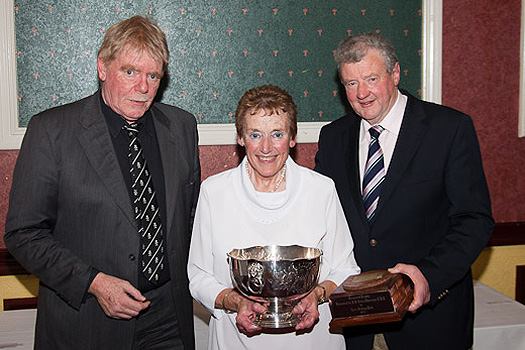
Cove Sailing Club Commodore Derry Allister (left) presents Sailing Journalist's Claire and Bob Bateman with the Foley Rose Bowl
The Bateman's were presented with the Foley Rose Bowl trophy. The trophy was first presented to Cove Sailing Club in 1974 when the late Bryan Foley was Chairman of the Cork Harbour Commissioners. It has many illustrious names on it and is awarded on merit, to the class, club, boat, person or group who have in the opinion of Cove Sailing Club contributed significantly to the promotion of sailing in Cork Harbour.
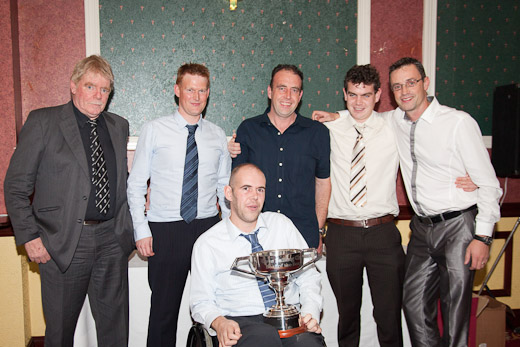
Boat of the year No Half Measures - Finbarr Dorgan (with trophy) and with Derry Allister crew (L-R)Kieran and Gareth Dorgan, Hal Courtney andRichard Marshall. They also won the overall Friday Night League for Kites IRC division.

Damian Aherne, skipper of Re Eile being presented with the September league IRC trophy for class 3. Derry and Brendan Ryan (Sailing Secretary) in
background
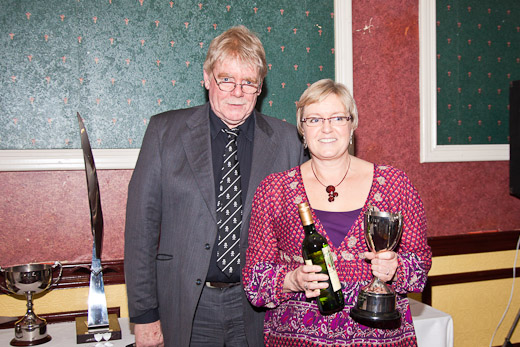
Ann Aherne being presented with the September League Echo trophy for class 3

John Doyle, Chanteuse presented with the Friday Night League Whitesail trophy
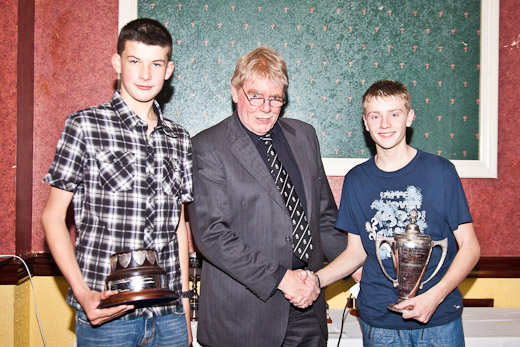
Dave Marshall and Rob Scandrett receiving the Ballinacurra Cup
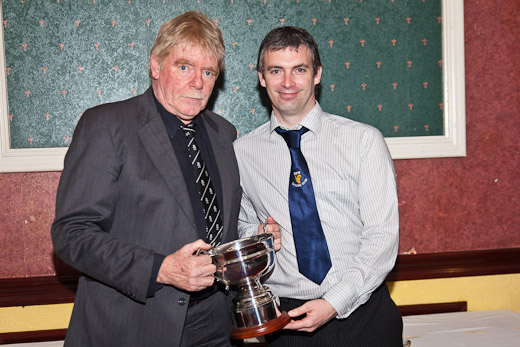
Club Person of the year Brendan Ryan (Sailing Secretary)
100 Boats Expected for Saturday's Cobh to Blackrock Yacht Race
This historic race – sponsored by the Port of Cork – will again feature strongly as one of the biggest events supporting this years Cork Harbour Open Day
Starting at midday off Cobh Promenade the race will continue along its traditional route passing Ringaskiddy, Monkstown, Passage, across Loch Mahon and along to the finish at Blackrock Castle.
All boats are then invited to continue up to the City Quays where complimentary berthing will be provided by the Port of Cork at the Cork City Marina.
A barbecue and usual refreshments will be available at the Boardwalk Restaurant (just opposite the City Pontoon) along Lapps Quay. The prize-giving will take place during the afternoon at the Boardwalk. Crews, their families and friends will have plenty of time to relax and enjoy themselves as we wind up the CSC laptop (and operators) to collate the dozens of times across all manner of classes in to a meaningful set of results.
The club would appreciate it if competitors would come along to support the after race festivities and prize-giving, especially if you think you may have won something. As always, the race is free to enter and a collection will be held for the RNLI during the afternoon.
Sunshine and Wind for Cobh People's Regatta (Pics here)
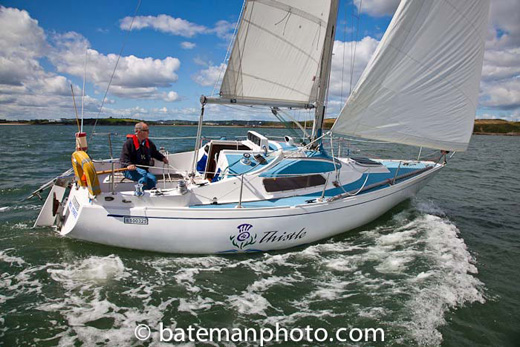


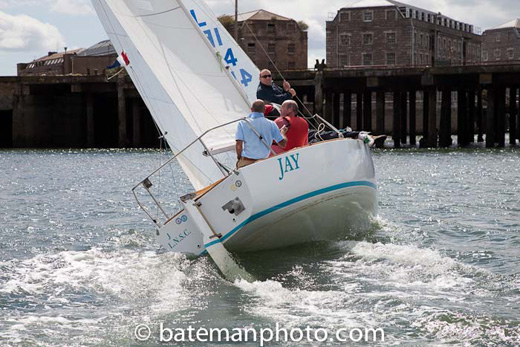
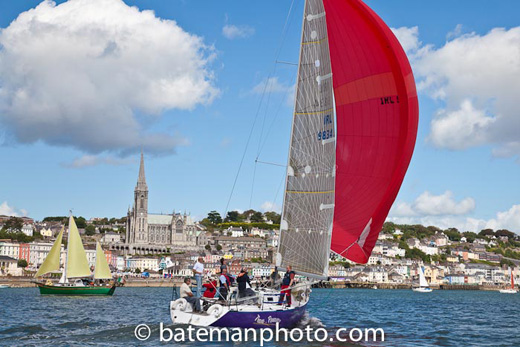
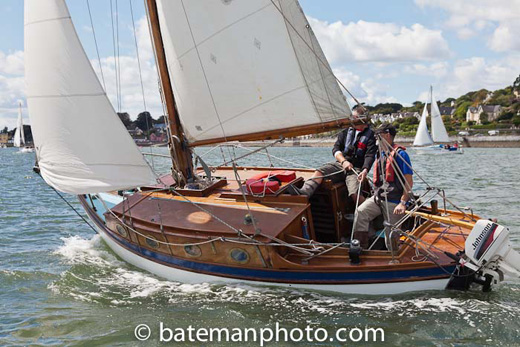
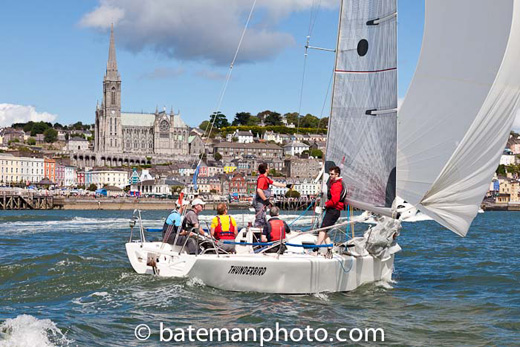
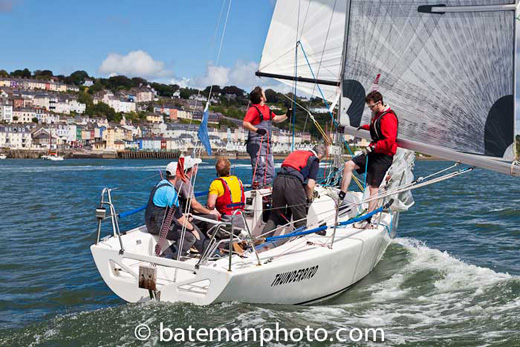
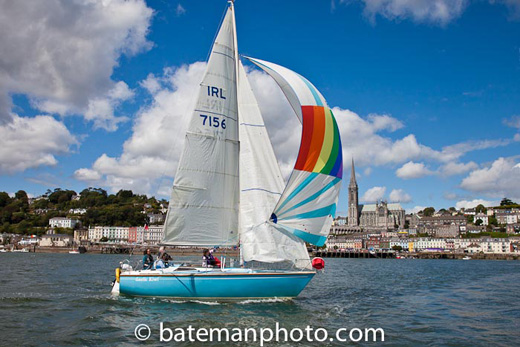



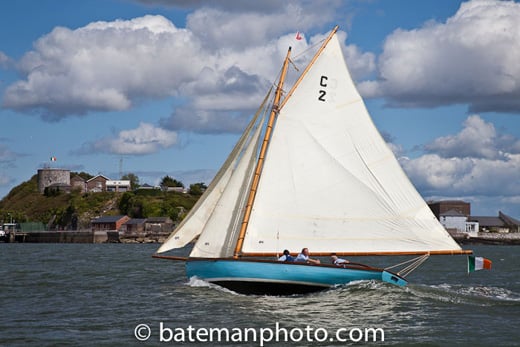
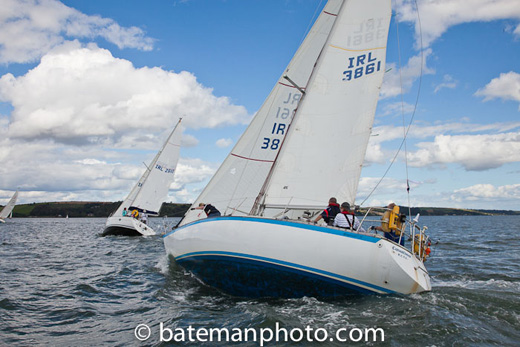
Racing Round Up: Lasers, E Boats, Puppeteers,DBSC, VDLR, Royal Cork, Cove and Sailor of the Month
In Cork Harbour 'Mid-Summer Madness' regatta attracted 40 Boats. We have the photos. There was a Fun Time for Cruisers at Cove Sailing Club's 'At Home' Regatta.
Galway's Martin Breen is June's Sailor of the Month and the Waterford Tall Ships Parade of Sail Photos are here.
Reasons to be cheerful? You bet. Click here to read how Dublin Bay sailors celebrate these wins.


























